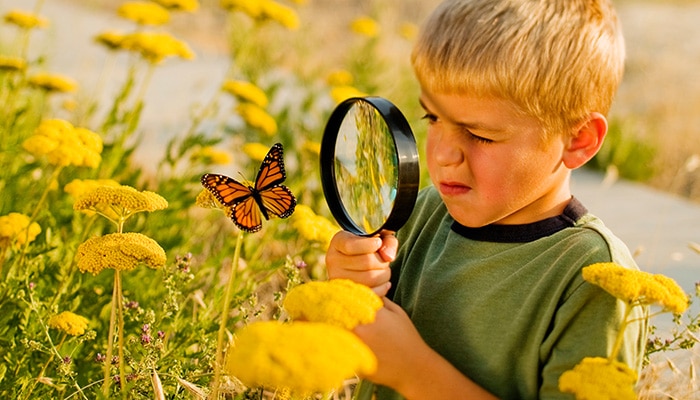While we believe that the books and resources recommended may be of value to you, keep in mind that these are suggestions only and you must do your own due diligence to determine whether the materials are appropriate and suitable for your use. PNC has no sponsorship or endorsement agreement with the authors or publishers of the materials listed.
CURIOUS CRAWLERS

Butterflies & Caterpillars
Children will explore the life cycle of a butterfly.

Lesson Objective
Children will learn about the life cycle of a butterfly as it grows from caterpillar to butterfly.
Science
What You'll Need
- Butterfly cage – available at discount stores, or use a 10-gallon aquarium with a mesh lid
- Monarch caterpillars – 5 – white, yellow, and black stripes (see Lesson Tips)
- Dirt – 2“ in cage
- Grass with roots
- Milkweed
- Branch of milkweed plant (where caterpillars and their eggs are found)
- Magnifying glasses – 1 per child
What To Do
Note: This lesson will take 2–3 weeks to complete. Try using monarch caterpillars (see Lesson Tips) because they will emerge from their chrysalis in only 14 days. You will need a daily supply of fresh milkweed for the caterpillar, enough for approximately 14 days.
- Display the caterpillar(s), and activate children’s background knowledge about caterpillars and butterflies (see Did You Know?).
- Tell the children they will be exploring the life cycle of a butterfly as it emerges from being a caterpillar to a beautiful butterfly. Make the children aware that once the butterflies have their wings, they will be released.
- Place dirt in bottom of the aquarium 2" deep. Plant the grass in the dirt. If you are using a butterfly cage, you can omit this step.
- Place caterpillar(s) attached to the branch of the milkweed plant where you found them in the cage/aquarium. Add another branch with leaves (replace with fresh leaves daily). Place the cage outside in a shady area. Lightly mist it once per day to maintain humidity.
- Have the children observe the caterpillar daily, add fresh milkweed, remove old leaves and excrement, and document any changes.
- Once the chrysalis has formed, have the children make predictions and track on a calendar the time it takes for the butterfly to emerge.
- When the butterfly emerges, its wings will be very wet, and it will not be able to fly until they are dry (3–4 hours).
- Once the butterfly’s wings are dry, release it to the outdoors.
Resources
Home School Resources
Home educators: use these printable lesson PDFs to teach this lesson to your home schoolers. They're available in English and Spanish.
Content Provided By
Common Core State Standards Initiative – These lessons are aligned with the Common Core State Standards ("CCSS"). The CCSS provide a consistent, clear understanding of the concepts and skills children are expected to learn and guide teachers to provide their students with opportunities to gain these important skills and foundational knowledge [1]. Visit the CCSS



